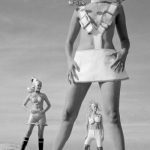This is the first extract from Mark Walsh’s upcoming book on the body and leadership.
…………….
“Few of us have lost our minds, but most of us have long ago lost out bodies” – Ken Wilber
Houston, We Have a Bodymind Problem
We’ve got a major problem: we have lost our bodies and in doing so much of our minds, hearts and souls. The modern world is hyper-mental, obsessed with the tenth of us above our necks and we’re all suffering as a result. The splitting off and privileging of mind over body has roots in Medieval Christianity, western philosophers like Descartes (I THINK therefore I am (a geek), the scientific endeavour and industrialisation. This is not an academic point however – and by academic I mean overly cerebral and therefore IRRELEVANT – as it leads to many of the challenges facing the world today. Self-inflicted ill-health (we are fatter, more addicted, more psychologically medicated and more suicidal than any generation ever for example), immanent environmental destruction, widespread war and terrorism, abandoning values at home on our way to work leaving those with the values of rapist sharks to lead gross financial inequality, an education system that dehumanises rather than develops our children …. to name a few disembodied pathologies. On an individual basis disembodiment limits what we are capable of achieving and feeling, knee-capping our endeavours and relationships, and isolating us from ourselves. This book is a practical guide to getting out of our heads and into our bodies so we can get on with what we need to do in the world. This to me is leadership, not some grandiose moustached calvary charge, limited to impressive historical figures, but leading life at work, and as parents or partners at home, in accord with values and purpose. In short, getting on with it.
above our necks and we’re all suffering as a result. The splitting off and privileging of mind over body has roots in Medieval Christianity, western philosophers like Descartes (I THINK therefore I am (a geek), the scientific endeavour and industrialisation. This is not an academic point however – and by academic I mean overly cerebral and therefore IRRELEVANT – as it leads to many of the challenges facing the world today. Self-inflicted ill-health (we are fatter, more addicted, more psychologically medicated and more suicidal than any generation ever for example), immanent environmental destruction, widespread war and terrorism, abandoning values at home on our way to work leaving those with the values of rapist sharks to lead gross financial inequality, an education system that dehumanises rather than develops our children …. to name a few disembodied pathologies. On an individual basis disembodiment limits what we are capable of achieving and feeling, knee-capping our endeavours and relationships, and isolating us from ourselves. This book is a practical guide to getting out of our heads and into our bodies so we can get on with what we need to do in the world. This to me is leadership, not some grandiose moustached calvary charge, limited to impressive historical figures, but leading life at work, and as parents or partners at home, in accord with values and purpose. In short, getting on with it.
So What Went Wrong?
The body in the 21st Century Western world has been reduced to a few paltry things. The first is just that – a thing. A mechanical cart which carries our head around. Industrialisation was the process that first the UK then the rest of the world went through from the eighteenth century onwards where societies moved from a rural farming lifestyle to an urban mechanised one. The body began to be seen very much like a piece of factory equipment – a mechanical “it”. This narrative is so common in fact as to be largely unconscious and has only evolved slightly in modern times. Now the body is a commodity to be manipulated, forced and punished through diets and gyms into submission. We have turned a large part of ourselves, and what was once also considered a connection to wisdom and divinity, into a performance vehicle or fashion accessory. We expect our athletes to have no special moral or intellectual capacity (and the average football player lives up to this) as their bodies are simply performance machines. Equally we expect our intellectuals to be puny to complete the split. This viewpoint is so embedded in language that it is unconscious – we talk about “my body” as it it were a car or phone, separate an possessed by ourselves. This book is about how the body is much more than an “it”, and you will very likely find your own body more enjoyable, easy to relate to others with and useful as a result.
Predating industrialisation and the notion of the body as a machine however, is the idea that the body is somehow bad and dirty and must be repressed. This notion is strongly expressed by a number of mainstream monotheistic religions, whether the founders of these religions intended it this way or not. In Europe body-celebrating paganism was pushed aside by a form of Christianity that saw the body as sinful – soul and spirit were not embodied matters as far as they were concerned. This led to a repression of sex seen in Calvinism (a major influence on capitalism as it developed not coincidentally) and the Victorians…at least publicly. There is still a hangover from this period and many societies still have either an anorexic approach to sexuality or a bulimic obsession with it. In this light the body, as unavoidably sexual and necessary for distasteful reproduction, sadly is still seen as somewhat “naughty” in seminars on embodied learning. It is not uncommon for senior executives I work with to titter like embarrassed pubescents at the first mention of “the body”. Repressed and denied thoroughly in other areas, only sexual and toilet humour remains, as unfortunate necessities of a disembodied world and our obscenities reflect this. Fucking shit state of affairs.
expressed by a number of mainstream monotheistic religions, whether the founders of these religions intended it this way or not. In Europe body-celebrating paganism was pushed aside by a form of Christianity that saw the body as sinful – soul and spirit were not embodied matters as far as they were concerned. This led to a repression of sex seen in Calvinism (a major influence on capitalism as it developed not coincidentally) and the Victorians…at least publicly. There is still a hangover from this period and many societies still have either an anorexic approach to sexuality or a bulimic obsession with it. In this light the body, as unavoidably sexual and necessary for distasteful reproduction, sadly is still seen as somewhat “naughty” in seminars on embodied learning. It is not uncommon for senior executives I work with to titter like embarrassed pubescents at the first mention of “the body”. Repressed and denied thoroughly in other areas, only sexual and toilet humour remains, as unfortunate necessities of a disembodied world and our obscenities reflect this. Fucking shit state of affairs.
This history is also associated with male dominance as the body was associated with women. Women’s intuition, women’s emotions, etc; and the powerful men with the purely cerebral. Bollocks…and tits…to that.
The picture I have painted is in one way tragic and in another has been developmentally necessary. We have gone through a process of disembodiment and hyper-rationalism which has perhaps enabled many of the splendours of the modern world Western world – low infant mortally, an abundance of food and technology that frees up time for specialisation and sent us to the symbol of feminine mystery – the moon (ahhh, now the title above kinda makes sense). These gifts have also come at a cost however and it is time to reintegrate the body into the equation…before it’s too late.
The Body’s Back and She’s Pissed Off
Happily things started to get better in the 60’s. As social systems loosened and changed (the 50’s were as disembodied as any Victorian nightmare), new ideas blossomed and the body started to come back “online”. People started to re-experience the essence of this work: learning from the body not just about the body. Embodied sexual freedom burst forth, numerous schools of body-based therapy and dance were founded and physical disciplines such as yoga and martial arts were imported from the East (which has to some degree had the same problem but not as severe) and began to take root. Freeing the body also coincided with new freedoms in civil rights, gender equality and environmental concerns and this is no coincidence as care for others and the planet is very much an embodied privilege. More and more people began to develop to a degree where they could see could start to self-observe and were realising that we are not neutral observers but that we “see things as we are, not [just] how they are” – Humberto Maturana. This was the modern birth of what I refer to in this book as embodied training and learning.
Today science is catching up with common sense and a sound academic and theoretical basis for embodied learning is starting to emerge. See for example Antonio Damasio on how embodied emotions are integral to thinking or the work of artificial intelligence pioneers on “embodied cognition”. Old science fiction ideas of brains floating in tanks or personalities downloaded to computers have been shown to be pure fiction – the brain, emotions and personality cannot be separated out from the body anymore than you can take the red from a rose. The implications of this are huge and what this book is about.
If the 60’s and 70’s were the first reappearance of the body in the West on any large scale, what is the situation today? Well, the 80s was a dark time for the body as consumerism – which encourage us to look outside ourselves for solutions – stepped-up a gear and commercialised the body yet further. A warped view of the body as seen in barbie dolls and action-men has emerged and we are given an ever increasing number of ways to numb and distract ourselves from the message our bodies are crying to give us… AND at the same time embodied practices like yoga and tai chi have spread far and wide to meet real needs that can’t be bought off. We stand at a crossroads with disembodied disaster on one side and a scary wonderful new way of being on the other. People will chose and we will all suffer, or enjoy, the consequences.
My generation is the first to grow up with sophisticated bodymind training in the West. What my teachers had to learn the hard way – and this book is hugely indebted to pioneers such as Richard Strozzi-Heckler and Paul Linden – was handed to me well formed. What I think my generation brings is a big-picture of the various traditions that are now readily available (Japanese aikido, Argentine tango and Thai meditation to name a few of my personal favourites for example) and the challenge becomes not just pluralism but integration. Whereas many embodied teachers from the 60’s and 70’s often worked away from or even against mainstream culture, we work with it
When one of my teachers brought embodied work to the military and business in the 80’s he was called a traitor and worse – thankfully that time is over. I work with business and mainstream institutions on a weekly basis and think that integration is now the challenge. This book is about bridging the gap between the “alternative” world which has a lot to offer to people who may never step into a Buddhist centre or kung-fu school, and the mainstream which not only now desperately needs this work for the reasons outlined, but also has a lot to teach in return. This book is founded as much on the logical intellectual rigour of science and the “what-works” approach of business, as it is on feeling, intuition and embodied spiritual wisdom. I believe in both “sides” of the bodymind puzzle and this is reason plus body not anti-intellectualism or feeling worship at the expense of sound logic – a mistake made by many in the early days of this work who threw the baby of modernist blessings out with the bathwater of disembodiment. If the 60’s was the swing back, this is the balancing and reintegration. Many thank to Ken Wilber for clarifying my thinking in this areas. Enough history already, let’s get on with
Some Outlandish Claims About Your Body
So if your body isn’t just an athletic performance machine, a sex machine or a cart for carrying that ugly bony lump around on, what on earth is it? Well here’s some areas that I would say the body is central to:
body is central to:
– Who you are (personality) and what you can do (action)
– Communication and social interaction
– Emotion and motivation
– Thinking and learning
– Spirituality, values, ethics and meaning
Take a look at the list again, I think most would agree that these are core aspects of being a human being. The body is always involved in whatever we do in fact – you could call it our operating system to use a modern metaphor – and yet the bodily aspects of life are usually ignored. Like the ancient Greeks and medieval Samurai whose gymnasia and dojos (places of “the way”) didn’t separate out physical education from personal and moral education, this book will explore life through the body. Much of the content comes from some very old traditions, which I’ve tried to give a modern taste and clear rigorous logical and experimental framework to avoid pre-modern superstition and stoned hippie nonsense.
Sign up for our monthly Email Newsletter to get updates on the book and embodied learning
Adrian Harris
I think your original contribution is the “what-works” approach exemplified by bringing embodied training into the mainstream. As you say the key is to get a synergy between what the old model took as ‘mind’ and ‘body’. That’s where embodiment research comes to the fore and it’s a really exciting time to be involved.
Jamie
Blake (and Mark, who likes what you say),
I have a problem with your choice of the words “feminized men” – being physically fit is not necessarily equivalent to being embodied. Is not a sensitive man an embodied man? and do you think BUTCH men, who are mostly out of touch with their feelings, especially their vulnerability, are “embodied men”? some things to consider….
Blake ludwig
Interesting post. I’m not sure I agree with everything you say. What I find most captivating in any physical exercise I do (hi intensity weight lifting, swimming, cycling) is that point where my attention drops from my mind and thoughts of limitation to a deeper and vaster place where I am not separate and am loving pushing further against any limits – the body or soul or whatever actually loves this.
I am reminded of Sri Chimnoy, a devotee Of Sri Auribindo, who broke every record he could to highlight the uberman, the evolving human that has the capacity to go beyond limitations.
I’m also feninded of the late Jack La lane who got us up in the mornings on tv and thru his own integrity tried to help us become fit and healthy human beings.
It seems a pity to see so many young men becoming so feminized and afraid of being an embodied man ,one who isn’t afraid of pushing their own limits of who and what they think they are. @compost2cosmos
Mark Walsh
Thanks Blake, I like what you say.
Louisa
Ok, nice to see you next to a green plant. Lots of colors on the shirt. Nice history lesson. Thanks for being a body/emotion advocate. Who is your audience? Are you doing Vipassana meditation now?
Mark Walsh
Thanks Louisa. I sit but mainly Zen. The book is for a general audience